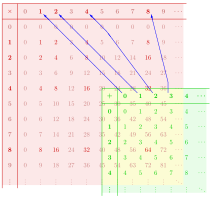
A | B | C | D | E | F | G | H | CH | I | J | K | L | M | N | O | P | Q | R | S | T | U | V | W | X | Y | Z | 0 | 1 | 2 | 3 | 4 | 5 | 6 | 7 | 8 | 9
In algebra, a homomorphism is a structure-preserving map between two algebraic structures of the same type (such as two groups, two rings, or two vector spaces). The word homomorphism comes from the Ancient Greek language: ὁμός (homos) meaning "same" and μορφή (morphe) meaning "form" or "shape". However, the word was apparently introduced to mathematics due to a (mis)translation of German ähnlich meaning "similar" to ὁμός meaning "same".[1] The term "homomorphism" appeared as early as 1892, when it was attributed to the German mathematician Felix Klein (1849–1925).[2]
Homomorphisms of vector spaces are also called linear maps, and their study is the subject of linear algebra.
The concept of homomorphism has been generalized, under the name of morphism, to many other structures that either do not have an underlying set, or are not algebraic. This generalization is the starting point of category theory.
A homomorphism may also be an isomorphism, an endomorphism, an automorphism, etc. (see below). Each of those can be defined in a way that may be generalized to any class of morphisms.
Definition
A homomorphism is a map between two algebraic structures of the same type (that is of the same name), that preserves the operations of the structures. This means a map between two sets , equipped with the same structure such that, if is an operation of the structure (supposed here, for simplification, to be a binary operation), then
for every pair , of elements of .[note 1] One says often that preserves the operation or is compatible with the operation.
Formally, a map preserves an operation of arity , defined on both and if
for all elements in .
The operations that must be preserved by a homomorphism include 0-ary operations, that is the constants. In particular, when an identity element is required by the type of structure, the identity element of the first structure must be mapped to the corresponding identity element of the second structure.
For example:
- A semigroup homomorphism is a map between semigroups that preserves the semigroup operation.
- A monoid homomorphism is a map between monoids that preserves the monoid operation and maps the identity element of the first monoid to that of the second monoid (the identity element is a 0-ary operation).
- A group homomorphism is a map between groups that preserves the group operation. This implies that the group homomorphism maps the identity element of the first group to the identity element of the second group, and maps the inverse of an element of the first group to the inverse of the image of this element. Thus a semigroup homomorphism between groups is necessarily a group homomorphism.
- A ring homomorphism is a map between rings that preserves the ring addition, the ring multiplication, and the multiplicative identity. Whether the multiplicative identity is to be preserved depends upon the definition of ring in use. If the multiplicative identity is not preserved, one has a rng homomorphism.
- A linear map is a homomorphism of vector spaces; that is, a group homomorphism between vector spaces that preserves the abelian group structure and scalar multiplication.
- A module homomorphism, also called a linear map between modules, is defined similarly.
- An algebra homomorphism is a map that preserves the algebra operations.
An algebraic structure may have more than one operation, and a homomorphism is required to preserve each operation. Thus a map that preserves only some of the operations is not a homomorphism of the structure, but only a homomorphism of the substructure obtained by considering only the preserved operations. For example, a map between monoids that preserves the monoid operation and not the identity element, is not a monoid homomorphism, but only a semigroup homomorphism.
The notation for the operations does not need to be the same in the source and the target of a homomorphism. For example, the real numbers form a group for addition, and the positive real numbers form a group for multiplication. The exponential function
satisfies
and is thus a homomorphism between these two groups. It is even an isomorphism (see below), as its inverse function, the natural logarithm, satisfies
and is also a group homomorphism.
Examples

The real numbers are a ring, having both addition and multiplication. The set of all 2×2 matrices is also a ring, under matrix addition and matrix multiplication. If we define a function between these rings as follows:
where r is a real number, then f is a homomorphism of rings, since f preserves both addition:
and multiplication:
For another example, the nonzero complex numbers form a group under the operation of multiplication, as do the nonzero real numbers. (Zero must be excluded from both groups since it does not have a multiplicative inverse, which is required for elements of a group.) Define a function from the nonzero complex numbers to the nonzero real numbers by
That is, is the absolute value (or modulus) of the complex number . Then is a homomorphism of groups, since it preserves multiplication:
Antropológia
Aplikované vedy
Bibliometria
Dejiny vedy
Encyklopédie
Filozofia vedy
Forenzné vedy
Humanitné vedy
Knižničná veda
Kryogenika
Kryptológia
Kulturológia
Literárna veda
Medzidisciplinárne oblasti
Metódy kvantitatívnej analýzy
Metavedy
Metodika
Text je dostupný za podmienok Creative
Commons Attribution/Share-Alike License 3.0 Unported; prípadne za ďalších
podmienok.
Podrobnejšie informácie nájdete na stránke Podmienky
použitia.
www.astronomia.sk | www.biologia.sk | www.botanika.sk | www.dejiny.sk | www.economy.sk | www.elektrotechnika.sk | www.estetika.sk | www.farmakologia.sk | www.filozofia.sk | Fyzika | www.futurologia.sk | www.genetika.sk | www.chemia.sk | www.lingvistika.sk | www.politologia.sk | www.psychologia.sk | www.sexuologia.sk | www.sociologia.sk | www.veda.sk I www.zoologia.sk





















